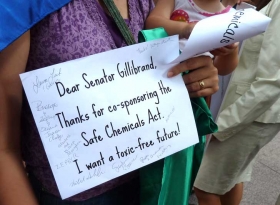I’ve been thinking a lot about the part of the environmental health movement that focuses on policy development and market shifts aimed at making our homes and workplaces safer.
Our grantees have made amazing progress against formidable opponents in the last ten years. They’ve mobilized diverse constituencies with science associating low-dose, everyday chemical exposures to a range of health conditions. Eighteen states have responded with almost 100 new laws, aligning them with EU reforms and applying pressure for US federal action. Forward thinking businesses are responding to consumer demands and seeking safer chemicals for their products. And polls repeatedly show that Americans rank Big Oil and Big Chemical as low as Big Tobacco.
So with all this success, why are many NGOs struggling financially? Why are key groups downsizing when they should be expanding to take advantage of the opportunities they’ve generated?
As usual, the answer is simple but the reasons are complicated. The simple answer is that new funders aren’t coming on board at the same rate as funders are cycling out with normal philanthropic attrition and issue migration.
But with all the successes from our environmental health investments so far, why have other funders been so slow to enter such a dynamic field? As I see it, there are two main reasons that new foundations are reluctant to join the party.
First, we’re Lilliputians: NGOs and funders alike are small, feisty and running rampant over a giant with many body parts. Chemicals: we’ve got 80,000! And campaigns are underway on cosmetics, cleaning supplies, baby products, electronics, furniture, clothing, cars, and buildings. And those are just the ones I can rattle off without thinking.
From the inside, we know this dizzying diversity is a powerful social movement. But for a new funder on the outside looking for a strategic entry point, it can look confusing and even chaotic.
It’s time that we Coalesce around common priority targets; discuss Consolidation where operations overlap; and consider Centralizing and upgrading some core functions. It’s time to stop being Lilliputians and grow in proportion to the Toxic Giant.
One very positive step is a new Hazardous Hundred Initiative that is unifying policy and market campaigners around 100 priority chemicals. It’s possible to envision the Hazardous Hundred also providing an orientation for body burden research, alternatives assessment and green chemistry. For more information contact Safer Chemicals Healthy Families.
Unified priorities and operations could also help address the second reason I believe our field is having difficulty attracting new donors: We don’t have yardsticks. Without metrics, it is hard to demonstrate impact, measure a return on investment, or make a compelling case for a new generation of social investors.
Prospective funders are asking for evidence of the causal relationships between chemical exposures and health impacts, and for metrics to guide investments aimed at improving health outcomes.
We may not be fully equipped to provide that information, but we need to figure it out. Because talking about multiple factors, simultaneous and ubiquitous exposures, and the limits of epidemiology and animal studies lead potential funding partners to wonder if resources would be better spent elsewhere.
We know the elements of a compelling case for improving health by reducing toxic exposures are out there. But we have to make this case more effectively to attract major new donors for this under-resourced field. I’m confident that we can and will meet this challenge together.
Ruth Hennig is Executive Director of the John Merck Fund. In addition to management responsibilities, Ruth functions as the director of the Environment program for the Fund and serves on the board of SmartPower. She was a founding advisory committee member of the New England Grassroots Environmental Fund, and until recently, a member of HEFN's Steering Committee.


